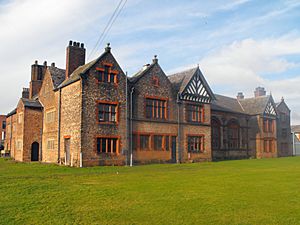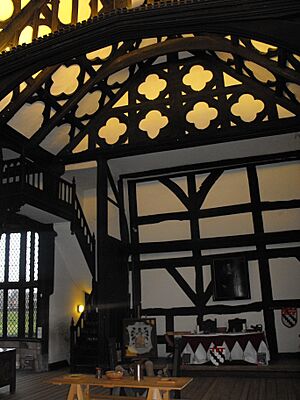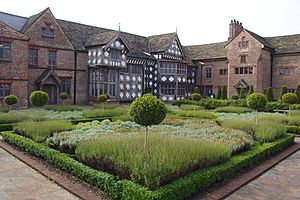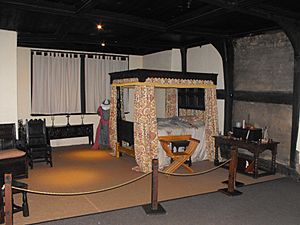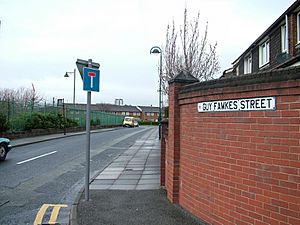Ordsall Hall facts for kids
Quick facts for kids Ordsall Hall |
|
|---|---|
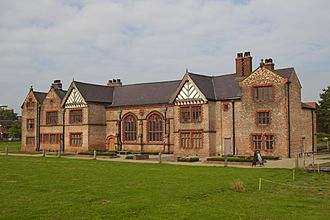
Ordsall Hall in 2014
|
|
| General information | |
| Town or city | Ordsall, Greater Manchester |
| Country | England |
| Coordinates | 53°28′10″N 2°16′39″W / 53.469444°N 2.2775°W |
| Designations | |
|
Listed Building – Grade I
|
|
| Official name: Ordsall Hall | |
| Designated: | 31 January 1952 |
| Reference #: | 1386169 |
Ordsall Hall is a very old and large house in Ordsall, Greater Manchester, England. It used to be a manor house, which means it was the main home for a wealthy family and their estate. The hall is over 750 years old, but the oldest parts you see today were built in the 15th century.
For more than 300 years, Ordsall Hall was the home of the Radclyffe family. They were very important in the area. A famous story says that the Gunpowder Plot of 1605 was planned here. This story was even used in a book called Guy Fawkes by William Harrison Ainsworth in 1842.
After the Radclyffe family sold the hall in 1662, it was used for many different things. It was a club for working men, a school for people studying to become clergy (religious leaders), and even a radio station during World War II. In 1959, the local council bought Ordsall Hall. They opened it to the public in 1972 as a museum. You can visit Ordsall Hall for free today. It is a Grade I listed building, which means it is a very important historic place.
Contents
The Hall's Long History
Ordsall Hall is a Tudor mansion that once had a moat around it. The oldest parts of the building are from the 13th century. The first known owner was David de Hulton in 1251. The Radclyffe family took over the manor of Ordsall around 1335. Sir John Radclyffe officially became the owner in 1354. At that time, the manor included the house, plus lots of land for farming and forests.
The Radclyffe Family Home
In the 1340s, Sir John Radclyffe fought alongside King Edward III in France. He was very brave in battles like Crécy. As a reward, the King allowed Sir John to bring skilled weavers from Flanders (now part of Belgium) back to Ordsall. Sir John built homes for them on his estate.
At that time, English weaving was not very good. Clothes from Manchester were known for being poor quality. The Flemish weavers taught local people their skills. They also started making silk, which helped Manchester become famous later for its cotton industry.
A Dutch scholar named Erasmus visited Ordsall Hall in 1499. He wrote about the floors, saying they were made of clay and covered with layers of rushes. He mentioned that these rushes were not changed often, which made the floors quite dirty!
The main part of the hall, called the Great Hall, was rebuilt in 1512. This happened after Sir Alexander Radclyffe became the High Sheriff of Lancashire. The Great Hall is one of the largest of its kind in northwest England. It has a very fancy roof.
More changes were made to the hall in the 17th century. A brick house was added in 1639. This might have been for Sir Alexander's manager, as he was not living in the hall full-time anymore. During the Civil War, Sir Alexander supported the King. He was put in prison and lost a lot of money. Because of this, his son, John Radclyffe, had to sell the hall in 1662. This ended over 300 years of the Radclyffe family living there.
Later Owners and Uses
In 1666, Ordsall Hall was the biggest house in Salford. It had 19 fireplaces! The Oldfield family bought the estate in the late 1600s. Then, in 1704, it was sold to John Stock. His family was probably the last to live in the hall full-time. They lived in the middle part of the house, which had many rooms, a chapel, and a stable. The two side parts of the hall were rented out to other people.
In 1756, Samuel Hill bought the hall. When he died two years later, it went to his nephew, Samuel Egerton. The hall continued to be lived in until 1871.
Later in the 1800s, the area around Ordsall Hall became very industrial. From 1875, a mill company rented the hall and used it as a working men's club. The Great Hall became a gym. There were also places for billiards and bowling.
In 1883, Lord Egerton bought the hall. He had it restored between 1896 and 1898. This cost a lot of money. After the restoration, Lord Egerton started a school there to train clergy. A church and a new servants' wing were built for the school. The school moved in 1908. The men's club at Ordsall Hall stayed open until 1940. During World War II, the hall was used as a radio station. The church and servants' wing were taken down in the 1960s.
Salford Council bought Ordsall Hall in 1959. After a lot of repair work, it opened to the public in April 1972. It became a museum where you could see how people lived in the past and learn about local history.
Like many old buildings, Ordsall Hall has ghost stories. People say a "White Lady" appears in the Great Hall or Star Chamber. Many believe she is Margaret Radclyffe. The story says she died of a broken heart in 1599 after her brother, Alexander, passed away in Ireland.
In 2007, a group asked for a large grant to fix up Ordsall Hall. They raised some money, and the Heritage Lottery Fund gave them the rest. The building closed for repairs in 2009 and reopened on May 15, 2011. In 2013, the newly restored hall won an award for being a great visitor attraction.
Hall Design and Features
Today, Ordsall Hall has two main parts. There is a timber-framed (wooden) section built in the 15th century. Then there is a brick section added in 1639. The hall was originally built around a central courtyard, but the other parts of that courtyard are gone now.
An old description from 1380 says the house had a main hall, five rooms, a kitchen, and a chapel. It also had stables, barns, a dovecote (for pigeons), an orchard, and a windmill. There was also a lot of land for farming.
Around the mid-1700s, some big changes were made. A floor was put into the Great Hall, and new rooms were created. The east part of the hall was probably taken down around this time, definitely before 1812.
People also believe there were secret underground tunnels leading from the hall into Manchester. One tunnel was said to go under the River Irwell to an inn. In 1900, a letter to a newspaper described a door in a cellar that might have been the entrance to such a tunnel.
The Guy Fawkes Legend
In his 1842 book Guy Fawkes, Harrison Ainsworth wrote about a local story. It said that the Gunpowder Plot of 1605 was planned by Guy Fawkes and Robert Catesby in Ordsall Hall's Star Chamber. The story also claims that Guy Fawkes escaped from the King's soldiers through a secret tunnel from Ordsall Hall. This tunnel supposedly led to an inn in Manchester.
There is no strong proof for this story. However, the Radclyffe family were Roman Catholics, and they knew the Catesby family. This made the story seem possible. Today, a road next to the hall is named Guy Fawkes Street, keeping the legend alive.
Gallery
See also
- Grade I listed buildings in Greater Manchester
- Listed buildings in Salford, Greater Manchester


